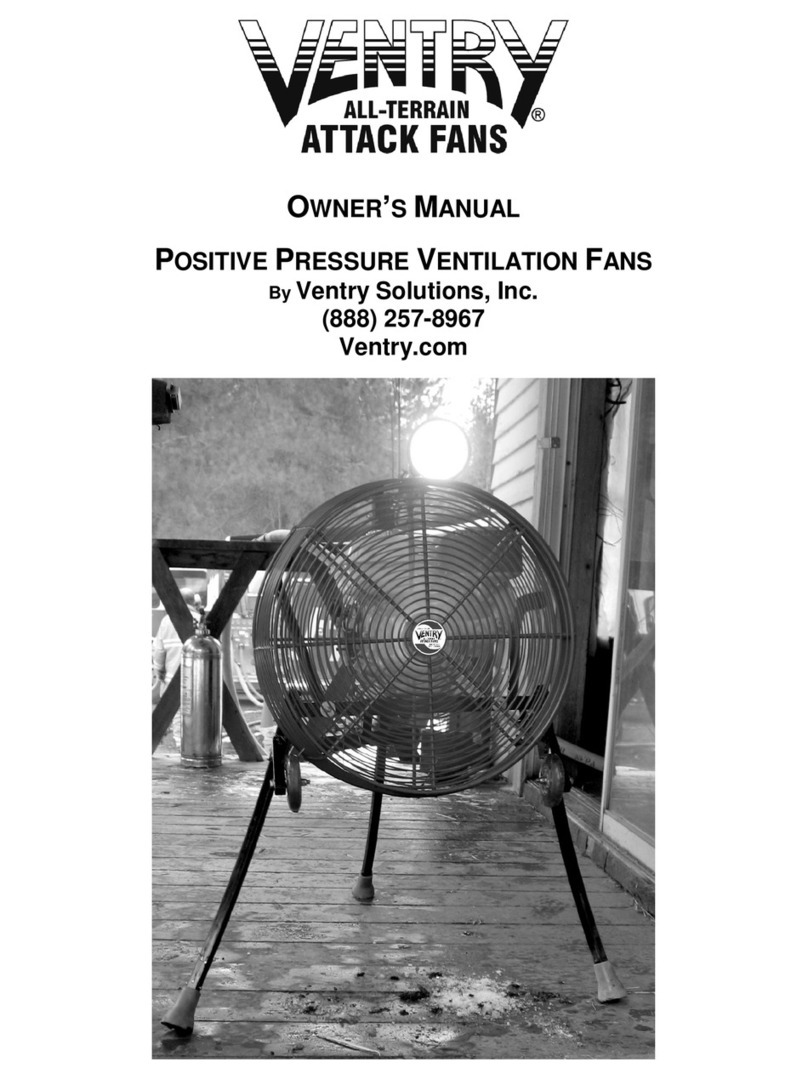
*HP (HORSEPOWER). specs show correct HP ratings, but many other PPV fan manufacturers continue to publish pre-VENTRY FAN
2007 values. Long ago, litigation changed the way Honda and other small engine manufacturers rated HP (Table 2). When
comparing fans, if the fans’ engines are equal in make and model, then the engines are equal in power, even if the HP ratings shown
do not match.
VOLUME. Air volume, in cubic feet per minute (CFM), is measured on VENTRY FANS with the legs
3
extended. Multiply by 1.69875 to convert this to meters cubed per hour (m /h).
Air volume (output) is a much better indicator of fan performance than engine horsepower
(input). However, because air volume is measured inconsistently in the industry, comparing
published CFM values is largely meaningless and in many cases misleading. We encourage
hands-on and side-by-side testing in order to truly compare CFM ratings.
THRUST. Based on Newton’s third law of motion, thrust is a measure of fan performance that
allows easy comparison of fans, with far fewer variables than direct measure of CFM. Simple instructions available upon request.
CARBON MONOXIDE. All VENTRY FAN models’ CO output at equilibrium are well below OSHA standards of 50 PPM.
HONDA GC- VS. GX-SERIES ENGINES. The GC160 motor is an economy option, rated as residential duty, while the heavier duty
Honda GX series motors (GX120, GX160, GX200) are rated commercial duty. GX motors also have cast iron bores instead of
aluminum, low-oil shut off protection, an on/off switch separate from the throttle, and a fuel shut-off valve. Warranties also differ.
Pg 1 of 2
Ventry Solutions, Inc.
(888) 257-8967 | 208-773-1194
Fax (208) 777-0360 | info@ventry.com
14128 N Hauser Lake Rd, Hauser, ID 83854
VENTRY.COM
( )
VENTRY SOLUTIONS, INC. • 888 257-8967 • ventry.com rev20210415 Fan Specs
SPECIFICATIONS
ALL-TERRAIN
PPV FANS
®
MOTOR MAKE HP RATINGS
& MODEL Pre-2007 Now
Honda GX120 4 hp à 3.5 hp
Honda GC160 5 hp à 4.6 hp
Honda GX160 5.5 hp à 4.8 hp
Honda GX200 6.5 hp à 5.5 hp
Table 2
Table 1
¸ Measurement not yet available
Patent 5,503,526
®
lSmoke-busting VENTRY SAFETY PROPELLERS. Two-
blade, aircraft propellers with vibration-dampening
wood cores and pressure-bonded fiberglass-and-
®
Kevlar outer structures for safety, high CFM
and longevity.
FEATURES OF ALL VENTRY® FANS
VOLUME THRUST CO FUEL RUN TIME ENGINE/MOTOR WARRANTY
MODEL TYPE PROP MOTOR/ENG. HP* (CFM) (LBS) (PPM) CAPACITY /TANK Commercial/Institutional Use
20EM3550 ®
Electric 20 Baldor EM3550 1.5 10,500 8.1 0 N/A N/A Motor 18 mos; Drive 18 mos
®
20GX120 Gas 20 Honda GX120 3.5 16,500 12.7 17 2.1 qts 1.8 hrs Engine: 3 years
20GC160 ¸ Gas 20 Honda GC160 4.6 17,000 13.5 1.9 qts 1.5 hrs Engine: 3 months
20GX160 ¸ Gas 20 Honda GX160 4.8 17,300 14.4 3.3 qts 2.0 hrs Engine: 3 years
24GX120 Gas 24 Honda GX120 3.5 20,000 17.6 16 2.1 qts 1.8 hrs Engine: 3 years
24GC160 Gas 24 Honda GC160 4.6 23,800 19.7 30 1.9 qts 1.5 hrs Engine: 3 months
24GX160 Gas 24 Honda GX160 4.8 24,000 19.8 32 3.3 qts 2.0 hrs Engine: 3 years
24GX200 Gas 24 Honda GX200 5.5 29,500 24.4 19 3.3 qts 1.7 hrs Engine: 3 years
lSolid stance on stairs or uneven ground and
the ability to straddle 12-inch high ground
cover, debris and equipment.
lCapable of rising at least 14 inches
above the ground, allowing aiming of
the air stream over obstacles such as
residential entry steps.
lFree-flowing, un-shrouded, double reinforced wire guards
that allow maximum air supply to propellers.
lRobust, powder-coated steel frames with
three individually adjustable solid aluminum
legs that provide three-point stability, all-
terrain versatility, and unlimited tilt/aiming.
lDual side handles for one- or
two-person transport.
lManufactured in our
Hauser, Idaho, USA
facility using only grade
8 hardware.






























